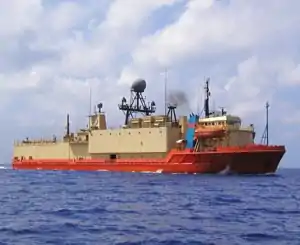MV Cory Chouest
MV Cory Chouest is an ocean surveillance ship leased by the U.S. Navy in 1989 and assigned to the Navy’s Special Missions Program. Cory Choquest had all SURTASS equipment removed and was returned to her original owners in 2008 completing nearly 20 years of service.[1]
 MV Cory Chouest | |
| History | |
|---|---|
| Name: | Cory Chouest |
| Owner: | Edison Chouest Offshore |
| Builder: | not known |
| Acquired: | leased for 5 years by the U.S. Navy, date unknown |
| In service: | as MV Cory Chouest in 1989 |
| Identification: |
|
| Fate: | Returned to Louisiana for redelivery to the owners |
| General characteristics | |
| Type: | ocean surveillance ship |
| Tons burthen: | 5,348 tons |
| Length: | 265' |
| Beam: | 60' |
| Draft: | 14' |
| Propulsion: | two diesels, two shafts, 4,000bhp |
| Speed: | 11 knots |
| Complement: | 16 civilian mariners, 41 military and sponsors |
| Sensors and processing systems: | both passive and active low frequency sonar arrays |
| Armament: | none |
Construction
Cory Chouest was acquired and modified by Edison Chouest Offshore for use by the U.S. Navy as a modified TAGOS vessel. Originally used as a research platform in conjunction with the Amy Chouest, the Cory was later modified to carry an active and passive sonar system. The vessel served until October 2008 when it went off charter.
Mission
The mission of Cory Chouest is to directly support the Navy by using both passive and active low frequency sonar arrays to detect and track undersea threats.
Operational history
In January 1991, the Cory Chouest and Amy Chouest were used as part of the Heard Island feasibility test, an experiment to transmit low frequency sound through the ocean from Heard Island in the Southern Indian Ocean[2] as far as both ocean coasts of the US and Canada.[3] The Cory Chouest was chosen because of its central moon pool and because it was already equipped with an array of low frequency transmitters. A phase-modulated 57Hz signal was used. The experiment was successful and demonstrated that such sound waves could travel as far as the antipodes. Planned transmissions had been for ten days, although owing to the bad weather conditions and the high failure rate of the transmitter elements, used at a frequency below their design frequency, the transmissions were terminated on the sixth day, when only two of the original ten transducers were still working.
Honors and awards
Cory Chouest personnel are qualified for the following medals:
- None currently noted.
Note
There is no journal entry on Cory Chouest at DANFS.
References
- "The Heard Island Feasibility Test". University of Washington. 2007.
- "Heard Island Feasibility Test - reception map". University of Washington. 2007.
External links
- NavSource Online: Service Ship Photo Archive - MV Cory Chouest
- Special Mission Program
- Military Sealift Command - Ship Inventory – MV Cory Chouest - Ocean Surveillance Ship
- Gordon D. Tyler, Jr.,″The Emergence of Low-Frequency Active Acoustics as a Critical Antisubmarine Warfare Technology", Johns Hopkins APL Technical Digest, Vol 13, No 1 (1992) p 145.
- Chouest
- PM2 - Special Mission Support Force